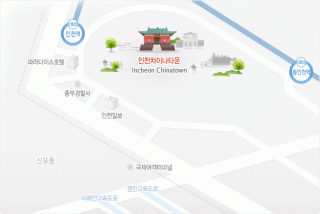Concession of Qing-Japan
Overview
In 1883, when Japan set aside 7,000 pyeong, mainly in the present Jungang Guhong area, Cheongguk set up the present Chinatown area as the boundary of the Japanese convent.
Now, when you climb 100 meters to the Free Park from the side of the Han Chinese Cultural Center, a stone step in the middle starts.
The stone lanterns installed on both sides of the road are divided into Chinese and Japanese style, and the Confucianism donated by the Chinese government of Qingdao City is located on the Chinese side based on the center of the stairs.
The history of Incheon Chinatown is over 100 years old. While not all traditional culture of the first generation has been preserved, the area still harbors many of the flavors of China.
Incheon became a China-friendly city after the modern opening of late 1800s. Korea started modern trade by signing the China–Korea Treaty of 1882 treaty with China in 1882. Incheon's Chinatown area came into being with the opening of the Incheon Port in 1883 and Incheon's designation as an extraterritoriality of the Ching Dynasty. After this, 'Incheon Chinese Society' (華僑) begun in earnest by establishing '淸國專管租界' (Chinese Settlement) in today's Incheon in 1885. 1883 report indicated that 63 Chinese people lived there. And they increased to 235 people in one year. In 1892, they increased to 637 people, and they increased to about 1000 people in early 1900. Overseas Chinese who currently live in Incheon in 2015 number 50,000 people. 'Incheon Chinatown' improved the relationship of Korea and China . Incheon Chinatown street name will change to China's well-known street or city names in 2016. Today, the Chinese residents of Chinatown are mostly 2nd or 3rd generations of early Chinese settlers.
It was designated as Incheon Metropolitan City Monument No. 51 on December 23, 2002. The designated area is 840㎡ and it is owned and managed by the Ministry of Construction and Transportation. This is a boundary area between the Japanese concession established in 1883 and the established Qing Dynasty in 1884, and it is connected with the national park (prefecture free park), and the stairs and the landscape are the space. It has a history of about 120 years. It has a stone staircase in the center. Considering that it is a steep slope area, it has enough space for stairs and landscaping planting space on both sides to make reasonable use of space. This staircase is centered on both sides of the traditional architectural style in which the buildings of the Qing Dynasty and Japan are clearly distinguished. The staircase itself is mediocre, but the place has a very high value and historicity.
Information from doopeida, wikipedia
Location:
Comments
Connections
- BaltimoreUnited States
- BaltimoreUnited States
- United States
- sea levelUnited States
- New YorkUnited States
- New York City
- San FranciscoUnited States
- BaltimoreUnited States
- BaltimoreUnited States
- United States
- YogyakartaIndia
- United States
- United States
- BronxUnited States
- United States
- MontclairUnited States
- taoyuan countyTaiwan
- New YorkUnited States
- YarmouthCanada
- New YorkUnited States
- GraftonCanada
- New York City
- YarmouthCanada
- United States
- Canada
Multimedia

Concession of Qing-Japan

Impacts
No impacts have been left for this site yet - be the first!










